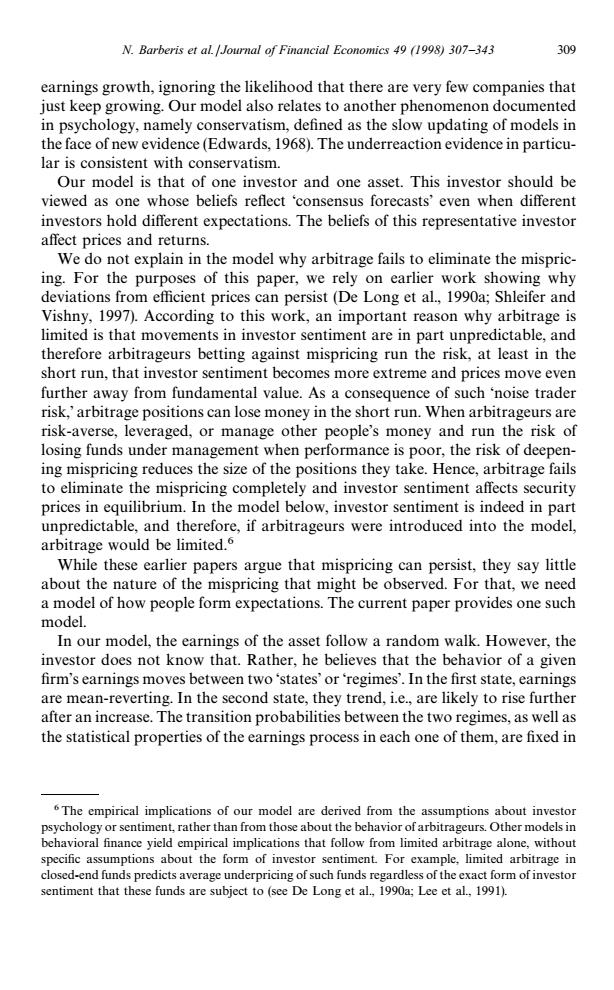正在加载图片...

N.Barberis et al./Journal of Financial Economics 49 (1998)307-343 309 earnings growth,ignoring the likelihood that there are very few companies that just keep growing.Our model also relates to another phenomenon documented in psychology,namely conservatism,defined as the slow updating of models in the face of new evidence(Edwards,1968).The underreaction evidence in particu- lar is consistent with conservatism. Our model is that of one investor and one asset.This investor should be viewed as one whose beliefs reflect 'consensus forecasts'even when different investors hold different expectations.The beliefs of this representative investor affect prices and returns. We do not explain in the model why arbitrage fails to eliminate the mispric- ing.For the purposes of this paper,we rely on earlier work showing why deviations from efficient prices can persist(De Long et al.,1990a;Shleifer and Vishny,1997).According to this work,an important reason why arbitrage is limited is that movements in investor sentiment are in part unpredictable,and therefore arbitrageurs betting against mispricing run the risk,at least in the short run,that investor sentiment becomes more extreme and prices move even further away from fundamental value.As a consequence of such 'noise trader risk,'arbitrage positions can lose money in the short run.When arbitrageurs are risk-averse,leveraged,or manage other people's money and run the risk of losing funds under management when performance is poor,the risk of deepen- ing mispricing reduces the size of the positions they take.Hence,arbitrage fails to eliminate the mispricing completely and investor sentiment affects security prices in equilibrium.In the model below,investor sentiment is indeed in part unpredictable,and therefore,if arbitrageurs were introduced into the model, arbitrage would be limited. While these earlier papers argue that mispricing can persist,they say little about the nature of the mispricing that might be observed.For that,we need a model of how people form expectations.The current paper provides one such model. In our model,the earnings of the asset follow a random walk.However,the investor does not know that.Rather,he believes that the behavior of a given firm's earnings moves between two'states'or 'regimes'.In the first state,earnings are mean-reverting.In the second state,they trend,i.e.,are likely to rise further after an increase.The transition probabilities between the two regimes,as well as the statistical properties of the earnings process in each one of them,are fixed in The empirical implications of our model are derived from the assumptions about investor psychology or sentiment,rather than from those about the behavior of arbitrageurs.Other models in behavioral finance yield empirical implications that follow from limited arbitrage alone,without specific assumptions about the form of investor sentiment.For example,limited arbitrage in closed-end funds predicts average underpricing of such funds regardless of the exact form of investor sentiment that these funds are subject to (see De Long et al.,1990a;Lee et al.,1991).6The empirical implications of our model are derived from the assumptions about investor psychology or sentiment, rather than from those about the behavior of arbitrageurs. Other models in behavioral finance yield empirical implications that follow from limited arbitrage alone, without specific assumptions about the form of investor sentiment. For example, limited arbitrage in closed-end funds predicts average underpricing of such funds regardless of the exact form of investor sentiment that these funds are subject to (see De Long et al., 1990a; Lee et al., 1991). earnings growth, ignoring the likelihood that there are very few companies that just keep growing. Our model also relates to another phenomenon documented in psychology, namely conservatism, defined as the slow updating of models in the face of new evidence (Edwards, 1968). The underreaction evidence in particular is consistent with conservatism. Our model is that of one investor and one asset. This investor should be viewed as one whose beliefs reflect ‘consensus forecasts’ even when different investors hold different expectations. The beliefs of this representative investor affect prices and returns. We do not explain in the model why arbitrage fails to eliminate the mispricing. For the purposes of this paper, we rely on earlier work showing why deviations from efficient prices can persist (De Long et al., 1990a; Shleifer and Vishny, 1997). According to this work, an important reason why arbitrage is limited is that movements in investor sentiment are in part unpredictable, and therefore arbitrageurs betting against mispricing run the risk, at least in the short run, that investor sentiment becomes more extreme and prices move even further away from fundamental value. As a consequence of such ‘noise trader risk,’ arbitrage positions can lose money in the short run. When arbitrageurs are risk-averse, leveraged, or manage other people’s money and run the risk of losing funds under management when performance is poor, the risk of deepening mispricing reduces the size of the positions they take. Hence, arbitrage fails to eliminate the mispricing completely and investor sentiment affects security prices in equilibrium. In the model below, investor sentiment is indeed in part unpredictable, and therefore, if arbitrageurs were introduced into the model, arbitrage would be limited.6 While these earlier papers argue that mispricing can persist, they say little about the nature of the mispricing that might be observed. For that, we need a model of how people form expectations. The current paper provides one such model. In our model, the earnings of the asset follow a random walk. However, the investor does not know that. Rather, he believes that the behavior of a given firm’s earnings moves between two ‘states’ or ‘regimes’. In the first state, earnings are mean-reverting. In the second state, they trend, i.e., are likely to rise further after an increase. The transition probabilities between the two regimes, as well as the statistical properties of the earnings process in each one of them, are fixed in N. Barberis et al./Journal of Financial Economics 49 (1998) 307—343 309